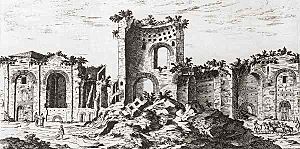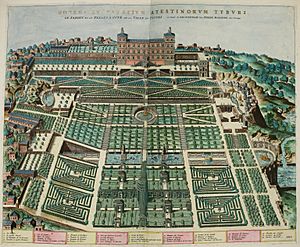Étienne Dupérac facts for kids

Étienne Dupérac (born around 1525, died in March 1604) was a talented French artist. He was an architect, painter, engraver, and even designed gardens! He is best known for his detailed drawings and maps of Rome and its ancient ruins in the late 1500s.
Contents
Étienne Dupérac: An Artist in Rome
Dupérac was born in Bordeaux or Paris, France. He moved to Rome in 1550 and quickly became a very skilled designer and engraver.
Exploring Ancient Rome
Dupérac created many famous works about Rome:
- He published a "bird's-eye view" of Ancient Rome. This showed how the city looked with its buildings rebuilt (called Urbis Romae Sciographia, 1574).
- He also made a similar view of modern Rome (called Descriptio, 1577).
- He released a book with forty detailed engravings of Roman monuments and old buildings. This book was titled I vestigi dell'antichità di Roma (Rome, 1575).
Dupérac's engravings of Rome helped spread new ideas about architecture and garden design. These ideas traveled from Italy to France and other parts of Europe. For example, his views of the Cortile del Belvedere and the Villa d'Este were very popular. Dupérac also worked for a time with another famous publisher, Antonio Lafreri.
Designing Gardens in France
Dupérac returned to France by 1578. There, he was asked to paint the Cabinet des Bains at the Château de Fontainebleau. He might have also designed some of the gardens there.
He is also thought to have designed the gardens at Château d'Anet. He worked as an architect for the duke of Aumale. Later, starting in 1595, he became an architect for King Henri IV. He may have designed the beautiful terraced gardens at Château de Saint-Germain-en-Laye. He also worked on the Tuileries in Paris from about 1600 to 1603.
Dupérac passed away in Paris.
His Legacy
An important collection of his drawings, signed by Dupérac and dated 1575, is kept in the Louvre. It is called Illustration des fragments antiques. Another etching from his work Speculum Romanae Magnificentiae is displayed in the Palazzo Braschi in Rome.
See also
 In Spanish: Étienne Dupérac para niños
In Spanish: Étienne Dupérac para niños


